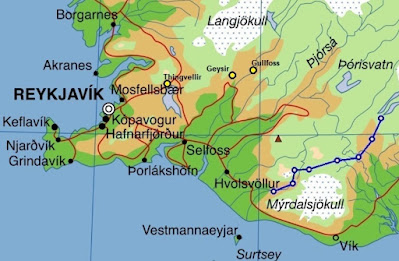links to: introduction and index - previous day - next day
Another extract from the notebook. Neville and I are on a guided walking tour in the south of Iceland with ten others. After two nights in the youth hostel at Reykjavik, today is the first day of the tour proper.
 |
South-West Iceland showing yesterday’s drive to Thingvellir, Geysir
and Gullfoss, and the walking route (east to west) in blue
|
Friday 26th August 1977
The route consists of ten days walking from mountain hut to mountain hut across an isolated and uninhabited part of southern Iceland, a total distance of about 70 miles (112 km). Huts are roughly 12 miles (20 km) apart, although sometimes we stay at the same hut two nights running. We carry our own clothes and sleeping bags, and a share of the equipment and provisions. We are warned we might have to carry loads of up to 44 lbs (20 kg) although it is normally much less. It would be more but for the advance food depots left along the route by the tour organiser. Even so, the food is mainly dehydrated carbohydrate such as porridge and pasta, plus tinned meat, bread until it runs out, then crackers and biscuits. We are also warned we should be able to walk double the distance in case of difficulties with routes or huts. These problems are only likely to arise earlier in the year, before mid-June, when there is more snow on the ground and the rivers are higher. Our walk, in August, is a soft option.

The tour is organised by Dick Phillips’ specialist Icelandic travel service which has been operating since 1960.
Dick Phillips is something of a legend and sounds a bit scary. He possesses an encyclopaedic knowledge of Icelandic landscape, culture and folklore.
He first visited the country several times in the nineteen-fifties, initially on a month-long cycling tour, and then on expeditions to the interior, including the first unassisted coast-to-coast crossing of Iceland by bicycle. He worked on a farm and lived in an upland community before converting an old farm house into a hostel.
The tour brochure shows him with a fearsome beard, wearing one of his distinctive Icelandic jumpers, checking out a glacial river crossing. He looks formidable, not to be messed with. He is also very smart. He appears to have sent the photographer across first.
Despite being a walking tour, this first day does not involve much
walking. It begins with a long cross-country ride of around 150
miles (240km) in a chunky, radio-equipped, four-wheel drive, low
gear-ratio, Icelandic mountain bus. It needs all this kit. Soon after
Selfoss, the bus turns left off the deteriorating road on to cindery, bull-dozed tracks, and then winds off-road across open country. It picks its way
through volcanic wastes, swerving to avoid boulders, rising and falling
to cross undulations and splashing through rivers. At one point it
crawls diagonally down a steep, unstable hillside, hoping not to start a
landslide. Few other vehicles would have been able to pass this point.
 |
| The view inside the bus, and out towards the Hekla volcano |
We stop to pick up Paul, our tour leader, who is waiting in a Land Rover. We are a little wary, unsure what to expect. Is he going to be another tough mountain guy like Dick Phillips, a commando boot camp bully or a snarling Eiger Sanction assassin? Surprisingly he is a pleasant, young, bespectacled, quietly spoken human being with shorts and suntanned legs.
He asks for help to unload provisions from the Land Rover, and Neville, ever the volunteer, rushes forwards. It doesn’t need all of us, only two or three. Neville returns arms filled with loaves of bread, highly appropriate for someone who works for a Hull bread manufacturer. The provisions are piled on to the overhead racks and vacant seats so as not to be squashed by the rucksacks in the luggage compartment. As the bus bounces over the rough terrain, my views to the south of the dormant Hekla volcano [it would next erupt in 1980], snow-capped and shining in the sunlight, are frequently disturbed by loaves of bread raining down on me.
At the front people are asking Paul about the tour, other tours, the elusive Dick Phillips and “what happens if …?” sort of things. Paul speaks slowly, emphasising each word as if painstakingly chosen, with long pauses at full stops and commas. He has a nice line in irony and understatement. He would like to be able to promise us a fortnight’s weather like today but he can’t of course. “Has it ever rained for two whole weeks?” “Yes,” replies Paul, “but I can’t guarantee it.” Someone else asks about crossing glacial rivers. “Sometimes, you can even get the bottom of your shorts wet,” says Paul, as if it is a pleasure.

Eventually the bus drops us in the middle of nowhere, at the side of a
small lake in a cindery, rock-strewn desert. We could be up a Knottingley slag
heap: the Black Hills of West Yorkshire. Despite the evening sun, it is surprising
how cold it is. There is a bitter wind. The provisions are divided up for us to carry, although Paul took the most. After
about an hour’s walk across a stream (wet foot but not wet shorts) and a
gap between gravel hills, we arrive at the Sveinstindur hut where we
are to stay for two nights.
I can now put names to half the
faces, but conversation remains guarded, formal and polite. It won’t
last. We are about to be holed up together for a week and a half like
Icelandic sheep herders.
 |
| Arriving at the Sveinstindur hut. Paul the leader, with his massive carrying frame, is on the left. |
(next part)
Some names and personal details have been changed. I would be delighted to hear from anyone who was there.









